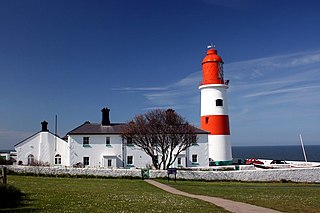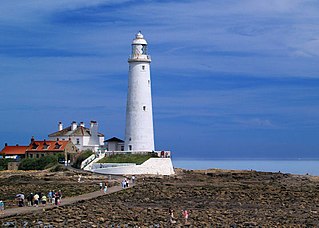Related Research Articles

Wallsend is a town in North Tyneside, Tyne and Wear, England, at the eastern end of Hadrian's Wall. It has a population of 43,842 and lies 4 miles east of Newcastle upon Tyne.

Gateshead is a town in the Gateshead Metropolitan Borough of Tyne and Wear, England. It is on the River Tyne's southern bank. The town's attractions include the twenty metre tall Angel of the North sculpture on the town's southern outskirts, The Glasshouse International Centre for Music and the Baltic Centre for Contemporary Art. The town shares the Millennium Bridge, Tyne Bridge and multiple other bridges with Newcastle upon Tyne.

South Tyneside is a metropolitan borough in the metropolitan county of Tyne and Wear, England.

North Tyneside is a metropolitan borough in the metropolitan county of Tyne and Wear, England. It forms part of the greater Tyneside conurbation. North Tyneside Council is headquartered at Cobalt Park, Wallsend.

South Shields is a coastal town in South Tyneside, Tyne and Wear, England; it is on the south bank of the mouth of the River Tyne. The town was once known in Roman times as Arbeia and as Caer Urfa by the Early Middle Ages. It is the fourth largest settlement in Tyne and Wear, after Newcastle upon Tyne, Sunderland and Gateshead.

North Shields is a town in the Borough of North Tyneside in Tyne and Wear, England. It is 8 miles (13 km) north-east of Newcastle upon Tyne and borders nearby Wallsend and Tynemouth.

North Shields Fish Quay is a fishing port located close to the mouth of the River Tyne, in North Shields, Tyne and Wear, North East England, 8 miles (13 km) east of the city of Newcastle upon Tyne.
The Meadow Well riots were a series of riots that took place during September 1991, starting on the Meadow Well council estate in North Shields, east of Newcastle, England, in response to a police enquiry, specifically regarding youths. The riots subsequently spread as far as Benwell, Scotswood, and Elswick in Newcastle upon Tyne, and Pennywell in Sunderland. They are regarded as some of the worst riots in British history.

Meadow Well is a Tyne and Wear Metro station, serving the suburbs of Chirton and Meadow Well, North Tyneside in Tyne and Wear, England. It joined the network as Smith's Park on 14 November 1982, following the opening of the fourth phase of the network, between Tynemouth and St James via Wallsend.

Longbenton is a district of North Tyneside, England. It is largely occupied by an extensive estate originally built as municipal housing by Newcastle City Council in the 1930s and extended in the 1950s. It is served by the Tyne and Wear Metro stations Longbenton Metro station and Four Lane Ends Metro Station. Nearby places are Killingworth, Forest Hall, Four Lane Ends, West Moor, Heaton and South Gosforth, in Newcastle upon Tyne. The Longbenton and Killingworth Urban Area had a population of 34,878 in 2001. This figure increased to 37,070 in 2011.

Byker is a district in the east of the city and metropolitan borough of Newcastle upon Tyne, in the county of Tyne and Wear, England. Home to the Byker Wall estate, made famous by TV series Byker Grove, Byker's population was recorded at 12,206 in the 2011 census. Byker is bordered by Heaton to the north and by Shieldfield to the north east. Until 1974 it was in Northumberland.

Shiremoor is a village in Tyne and Wear, Northern England. It is in the Metropolitan Borough of North Tyneside and formerly governed under Northumberland. In the 2011 census, it was included in the Tynemouth area of Tyneside. It is near the North East Green Belt, which surrounds Tyneside, Wearside and Durham. It is located around 3+1⁄2 miles from Whitley Bay.

Royal Quays is an area of North Shields, North Tyneside, England, beside the River Tyne.

Howdon is a largely residential area in the eastern part of Wallsend, Tyne and Wear, England. It consists of High Howdon and the smaller settlement of East Howdon. Much of the High Howdon area was formerly called Willington prior to post-World War II urbanisation. The North Tyneside ward population at the 2011 Census was 11,129.

Willington Quay is an area in the borough of North Tyneside in Tyne and Wear in northern England. It is on the north bank of the River Tyne, facing Jarrow, and between Wallsend and North Shields. It is served by the Howdon Metro station in Howdon. The area from 2006 onwards has been an area of new housing built on brownfield sites. The house building continues into 2013 and is changing the social and economic balance in the area. The area has also had a make over of the bowling green off Howdon Lane and further warehousing next to the bowling green has been demolished to make way for further new housing. The changes made recently at Willington Quay are now making it an attractive place to live within North Tyneside.
Benton is an area of North Tyneside in Tyne and Wear, England. It is 4 miles (6 km) to the north east of Newcastle upon Tyne. The parish of St Bartholomew, Longbenton, is within the North Tyneside district. The population of the North Tyneside Ward taken at the Census 2011 was 10,359. The area is contiguous with the suburbs of Newcastle.

Newcastle City Centre is the city centre district of Newcastle upon Tyne, England. It is the historical heart of the city and serves as the main cultural and commercial centre of the North East England region. The city centre forms the core of the Tyneside conurbation.

Jesmond is a suburb of Newcastle upon Tyne, Tyne and Wear, England, situated north of the city centre and to the east of the Town Moor. Jesmond is considered to be one of the most affluent suburbs of Newcastle upon Tyne, with higher average house prices than most other areas of the city.
Percy Main is a small village absorbed into North Shields, North East England. Historically in Northumberland, it is now part of Tyne and Wear.
References
- ↑ Sonia Sharma (8 September 2016). "Meadow Well riots 25 years on: An estate ravaged by violence shows little sign of its scars". nechronicle.
- ↑ "LOCAL HISTORY: Local Place Names Part 7 – Roundabout Publications". roundaboutpublications.co.uk.
- ↑ Kate Proctor (11 June 2014). "Stories that shocked Tyneside: The Meadow Well riots in North Shields". nechronicle.
- ↑ "Meadow Well: Is the stigma unfair 30 years after riots?". BBC News. 9 September 2021.
- ↑ Interactive, Enigma. "St Joseph's Roman Catholic Primary School | North Shields | North Tyneside". www.stjosephsrc-primary.co.uk. Retrieved 2020-02-15.
- ↑ Interactive, Enigma. "Riverside Community Primary School and Nursery | North Shields | North Tyneside". www.riversideprimary.net. Retrieved 2020-02-15.
- ↑ Interactive, Enigma. "Waterville Primary School | North Shields | North Tyneside". www.watervilleprimary.org.uk. Retrieved 2020-02-15.